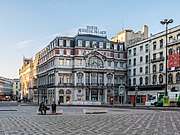José Luís Monteiro
José Luis Monteiro (1848–1942) was a Portuguese architect.[1] His work is considered among the most influential within late 19th century architecture.[2][3]
José Luis Monteiro | |
|---|---|
.png) | |
| Born | October 25, 1848 Lisbon, Portugal |
| Died | January 27, 1942 Campo de Ourique, Portugal |
| Occupation | Architect |
Life
José Luis Monteiro was born in Lisbon, Portugal on October 25, 1848.[4] At age 12, Monteiro enrolled in the Royal Academy of Fine Arts in Lisbon. In 1873 he moved to Paris to attend the École nationale supérieure des Beaux-Arts in Paris, completing his degree under the mentorship of Jean Louis-Pascal in 1879.[5]
In 1880, Monteiro returned to Portugal where he assumed a role as chief architect for the Lisbon City Council, in addition to a teaching position at the city's Royal Academy of Fine Arts, where he originally trained.[5] In 1901 he was awarded the Legion of Honor.[4]
Monteiro died on January 27, 1942 in Campo de Ourique, Portugal.
Work
Monteiro utilized a number of different architectural styles including Neoclassicism and French Second Empire. He is most well known for his revolutionary use of metal in the interior Rossio Railway Station; the building contained one of the first iron vaults in the nation.
Notable projects
- Hôtel de Ville (reconstruction), Paris, 1874[1]
- Rossio Railway Station, Lisbon, 1886[6]
- Liceu Nacional Passos Manuel, Lisbon, 1881
- Hotel Avenida Palace, Lisbon, 1890[4]
- Igreja dos Anjos, Lisbon, 1908[1]
 Hôtel de Ville, Paris, 1874
Hôtel de Ville, Paris, 1874.jpg) Estação Rossio, Lisbon, 1886
Estação Rossio, Lisbon, 1886 Hotel Avenida Palace, Lisbon, 1890
Hotel Avenida Palace, Lisbon, 1890 Igreja dos Anjos, Lisbon, 1908
Igreja dos Anjos, Lisbon, 1908
References
- "José Luis Monteiro - Oxford Reference". www.oxfordreference.com. doi:10.1093/oi/authority.20110803100207162. Retrieved 2019-01-27.
- Burman, Peter (1998). Architecture 1900. Donhead. ISBN 9781873394328.
- Cini.", Fondazione "Giorgio (1966). Encyclopedia of World Art: Pakistan to Rembrandt. McGraw-Hill.
- "Arquivo Municipal de Lisboa - José Luís Monteiro". arquivomunicipal.cm-lisboa.pt. Retrieved 2019-01-27.
- Faria, Alberto. Três desenhos da aula de Arquitectura do "Mestre Monteiro" (PDF).
- DK (2014-04-01). DK Eyewitness Travel Guide: Portugal. Penguin. ISBN 9781465422118.